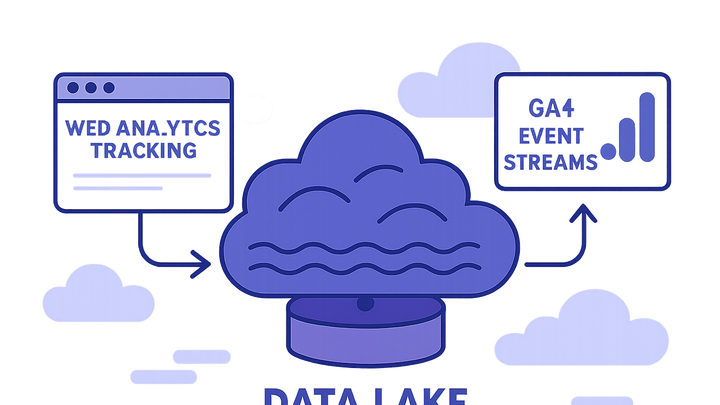Published on 2025-06-22T02:48:59Z
What is a Data Lake? Examples for Analytics
Data Lake is a centralized repository for storing vast amounts of raw data in its native format until it’s needed for analysis. In the analytics industry, data lakes handle varied data types—from structured event logs to unstructured text—enabling flexible, on-demand processing. By decoupling storage from compute, they offer scalability and support advanced analyses like machine learning. For example, you can push event data directly from a cookie-free analytics provider like PlainSignal using a simple tracking snippet:
<link rel="preconnect" href="//eu.plainsignal.com/" crossorigin />
<script defer data-do="yourwebsitedomain.com" data-id="0GQV1xmtzQQ" data-api="//eu.plainsignal.com" src="//cdn.plainsignal.com/plainsignal-min.js"></script>
Similarly, Google Analytics 4 (GA4) can stream events to BigQuery—a cloud data warehouse that doubles as a data lake foundation—unlocking raw event exports and custom querying capabilities.
Data lake
Scalable repository for storing all types of raw analytics data for flexible, on-demand processing.
Understanding Data Lakes
This section covers the fundamental concepts and characteristics of a data lake within analytics contexts.
-
Definition
A data lake is a centralized storage system that holds raw data in its native format.
-
Core characteristics
Key features that distinguish data lakes from other storage solutions.
-
Centralized repository
Stores diverse data sources in one location.
-
Raw data storage
Keeps unprocessed data intact until analysis.
-
Schema-on-read
Applies schema at the time of analysis rather than on ingest.
-
-
Data types
Data lakes support multiple data formats and structures.
-
Structured data
Rows and columns from databases or CSV files.
-
Semi-structured data
JSON, XML, or other self-describing formats.
-
Unstructured data
Text documents, images, audio, and logs.
-
Benefits of Data Lakes in Analytics
Explores why analytics teams leverage data lakes to gain insights and drive decisions.
-
Scalability and cost-efficiency
Data lakes use commodity hardware and cloud storage for cost-effective scaling.
-
Flexibility and schema-on-read
Allows storing raw data without upfront schema design, enabling agile analysis.
-
Advanced analytics and machine learning
Supports big data processing frameworks (e.g., Spark) and ML workflows directly on raw data.
Data Lake vs Data Warehouse
Contrasts data lakes with traditional data warehouses to clarify use cases.
-
Purpose and use cases
Data warehouses serve BI reporting on curated data; data lakes handle exploratory analytics on raw data.
-
Schema management
Warehouses enforce schema-on-write; lakes defer schema definitions until read time.
-
Performance and cost trade-offs
Warehouses optimize query speed on structured data at higher cost; lakes offer cheaper storage but may need additional compute.
Implementing a Data Lake with SaaS Analytics
Practical steps to ingest and manage analytics data from SaaS platforms into a data lake.
-
Ingesting PlainSignal data
Capture event streams from PlainSignal using its cookie-free tracking script.
-
Tracking script setup
Embed PlainSignal snippet in your website to start data flow.
-
Pipeline configuration
Use ETL/ELT tools (e.g., Fivetran) or serverless functions to load data into the lake.
-
-
Integrating GA4 exports
Export GA4 events to BigQuery and treat it as part of your data lake.
-
Enable bigquery export
Activate continuous GA4 export in the property settings.
-
Query raw events
Use SQL in BigQuery to analyze raw GA4 data.
-
-
Storage solutions and tools
Choose storage and processing frameworks for your lake.
-
Object storage
Use AWS S3, Google Cloud Storage, or Azure Blob for scalable storage.
-
Processing engines
Leverage Spark, Presto, or serverless query services like Amazon Athena.
-
Best Practices for Data Lake Management
Guidelines to maintain a reliable, secure, and performant data lake.
-
Data governance and security
Implement access controls, encryption at rest/in transit, and auditing.
-
Data quality and cataloging
Use tools like AWS Glue Data Catalog or Apache Atlas to document datasets and ensure data integrity.
-
Monitoring and maintenance
Set up alerts on storage usage, pipeline failures, and data freshness.
